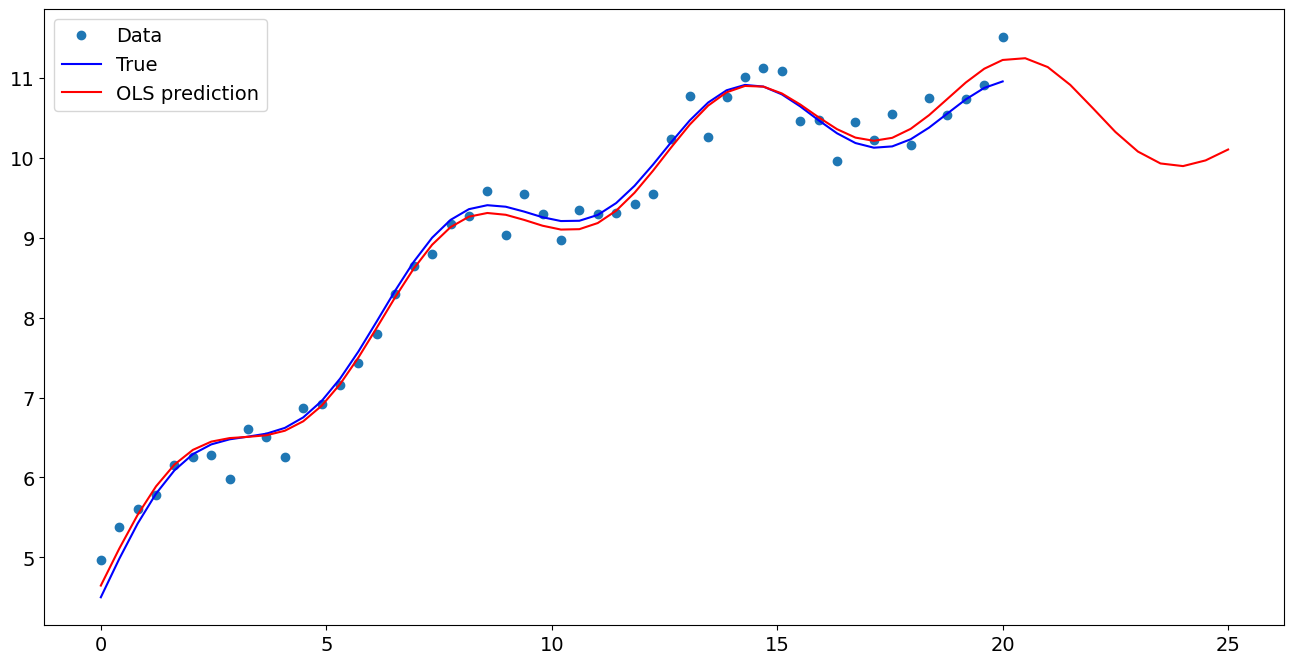Prediction (out of sample)¶
[1]:
%matplotlib inline
[2]:
import numpy as np
import matplotlib.pyplot as plt
import statsmodels.api as sm
plt.rc("figure", figsize=(16, 8))
plt.rc("font", size=14)
Artificial data¶
[3]:
nsample = 50
sig = 0.25
x1 = np.linspace(0, 20, nsample)
X = np.column_stack((x1, np.sin(x1), (x1 - 5) ** 2))
X = sm.add_constant(X)
beta = [5.0, 0.5, 0.5, -0.02]
y_true = np.dot(X, beta)
y = y_true + sig * np.random.normal(size=nsample)
Estimation¶
[4]:
olsmod = sm.OLS(y, X)
olsres = olsmod.fit()
print(olsres.summary())
OLS Regression Results
==============================================================================
Dep. Variable: y R-squared: 0.985
Model: OLS Adj. R-squared: 0.984
Method: Least Squares F-statistic: 1032.
Date: Wed, 08 May 2024 Prob (F-statistic): 3.51e-42
Time: 23:03:48 Log-Likelihood: 4.1134
No. Observations: 50 AIC: -0.2269
Df Residuals: 46 BIC: 7.421
Df Model: 3
Covariance Type: nonrobust
==============================================================================
coef std err t P>|t| [0.025 0.975]
------------------------------------------------------------------------------
const 5.1147 0.079 64.584 0.000 4.955 5.274
x1 0.4840 0.012 39.629 0.000 0.459 0.509
x2 0.4327 0.048 9.011 0.000 0.336 0.529
x3 -0.0184 0.001 -17.175 0.000 -0.021 -0.016
==============================================================================
Omnibus: 0.714 Durbin-Watson: 1.964
Prob(Omnibus): 0.700 Jarque-Bera (JB): 0.756
Skew: -0.083 Prob(JB): 0.685
Kurtosis: 2.421 Cond. No. 221.
==============================================================================
Notes:
[1] Standard Errors assume that the covariance matrix of the errors is correctly specified.
In-sample prediction¶
[5]:
ypred = olsres.predict(X)
print(ypred)
[ 4.65425977 5.09565471 5.5026979 5.85180993 6.12792107 6.3269472
6.45646081 6.53444684 6.58634785 6.64088385 6.72533367 6.86105317
7.0599665 7.32260698 7.63802954 7.98560888 8.33842824 8.66770165
8.94750347 9.15902785 9.29367849 9.35448099 9.35558574 9.31994308
9.27553259 9.25076615 9.26981994 9.34866235 9.49243043 9.6945859
9.93798935 10.19771619 10.44515172 10.65269243 10.79828116 10.86903106
10.86334285 10.79116756 10.67237162 10.53347289 10.40328378 10.30817753
10.2677551 10.29162483 10.37782379 10.5131403 10.67528457 10.83655083
10.96836934 11.0460003 ]
Create a new sample of explanatory variables Xnew, predict and plot¶
[6]:
x1n = np.linspace(20.5, 25, 10)
Xnew = np.column_stack((x1n, np.sin(x1n), (x1n - 5) ** 2))
Xnew = sm.add_constant(Xnew)
ynewpred = olsres.predict(Xnew) # predict out of sample
print(ynewpred)
[11.04343058 10.92605836 10.7108508 10.43647391 10.15382578 9.91357492
9.75375487 9.69045225 9.71386819 9.79071745]
Plot comparison¶
[7]:
import matplotlib.pyplot as plt
fig, ax = plt.subplots()
ax.plot(x1, y, "o", label="Data")
ax.plot(x1, y_true, "b-", label="True")
ax.plot(np.hstack((x1, x1n)), np.hstack((ypred, ynewpred)), "r", label="OLS prediction")
ax.legend(loc="best")
[7]:
<matplotlib.legend.Legend at 0x7f74b1780370>

Predicting with Formulas¶
Using formulas can make both estimation and prediction a lot easier
[8]:
from statsmodels.formula.api import ols
data = {"x1": x1, "y": y}
res = ols("y ~ x1 + np.sin(x1) + I((x1-5)**2)", data=data).fit()
We use the I to indicate use of the Identity transform. Ie., we do not want any expansion magic from using **2
[9]:
res.params
[9]:
Intercept 5.114703
x1 0.484015
np.sin(x1) 0.432657
I((x1 - 5) ** 2) -0.018418
dtype: float64
Now we only have to pass the single variable and we get the transformed right-hand side variables automatically
[10]:
res.predict(exog=dict(x1=x1n))
[10]:
0 11.043431
1 10.926058
2 10.710851
3 10.436474
4 10.153826
5 9.913575
6 9.753755
7 9.690452
8 9.713868
9 9.790717
dtype: float64
Last update:
May 08, 2024